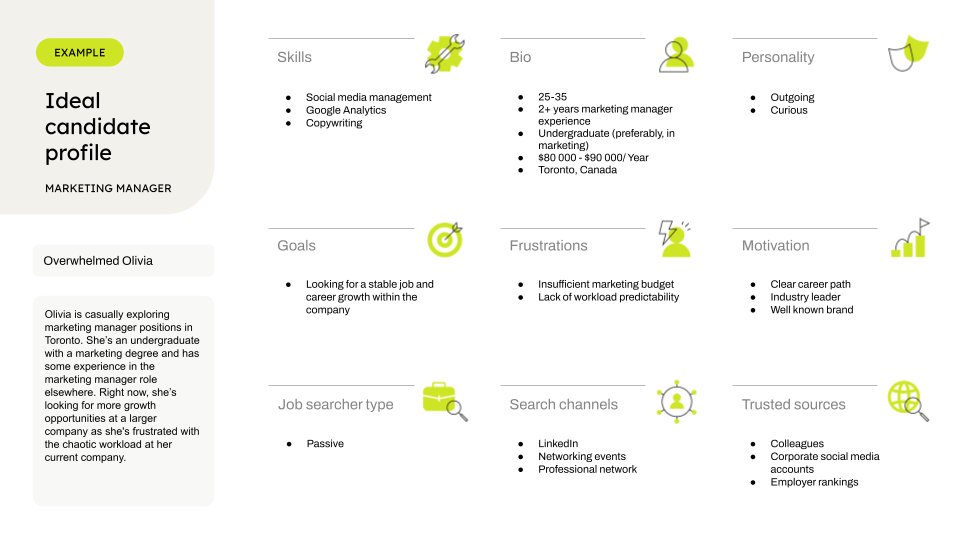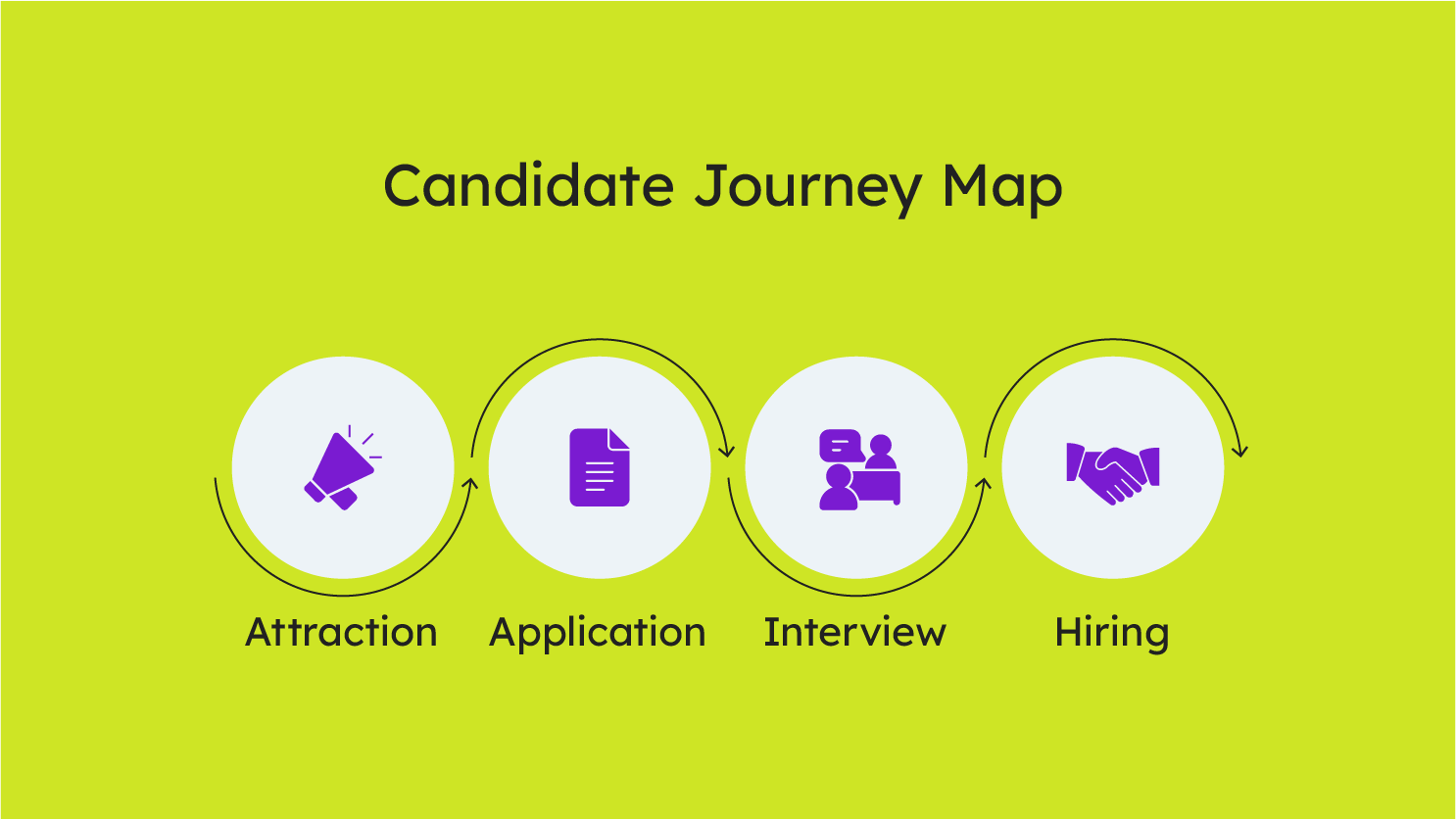From Clicks to Candidates
How marketing strategies can revolutionize your recruitment
Janis Kreilis
Preparation
Solid preparation is one of the most important steps in an efficient hiring process, yet sometimes, it gets overlooked.
To attract the best talent, we need to become candidate-centric in our approach. What does that mean? In marketing, a customer-centric approach refers to thinking about the needs of the customer, all the way from the design of our product to the wording in our ads, with the aim to continuously improve the overall customer experience. Similarly, candidate-centric recruiting simply means thinking about the needs of your candidates and optimizing every step of the hiring process to meet those needs.
Define your ideal candidate
To bring candidate-centric recruiting to life, you must first figure out who your candidates should be. Just as marketers use a framework called the_ ideal customer persona_, we can use the ideal candidate profile framework. It’s a fictional representation of your ideal candidate, based on data points and research about the organization’s current and desired employees.

To create the ideal candidate profile, you don’t need to do much extra work. Most likely, you’ll start your hiring process by discussing with the hiring manager the position you’re trying to fill. In the meeting, you’ll go over questions about what makes a great fit:
What skills the candidate should have
What experience would be beneficial to the role
What the new hire will do day-to-day
How the new team member will be expected to grow in the role etc.
Hiring managers could also tell you about certain characteristics that made previous employees in this or similar roles successful, or what kept them from performing well. This is already a great start for understanding who the ideal candidate may be.
Then, however, we need to go beyond their basic bio and also consider what would attract them to your company and role. What are their goals and frustrations? What motivates them? How do they search for and evaluate job opportunities? If possible, create the ideal candidate profile together with your hiring manager. It’s a great opportunity to get on the same page not only about who you’re looking for but also what would attract them to the role.
Get our ideal candidate profile canvas
Download our outbound recruitment essentials pack, which also includes:
21 questions for hiring managers
Outreach templates
Boolean and x-ray search cheat sheet
Next, we'd need to move from the ideal to the reality. Based on your ideal candidate profile, you could find ten actual profiles of potential candidates that match your vision and present them to the hiring manager. This helps keep the expectations realistic - sometimes, our ideal expectations simply don't align with the realities of the labor market, and in this case, the framework can help you start looking for trade-offs.
Name your character
Marketers love to name ideal customer profiles based on their characteristics to personalize them on a deeper level. This way, that recent computer science graduate who has shown great promise early in her career can become Gifted Gwen and a friendly customer service rep who can handle even the toughest of complaints can turn into Patient Paul. Alliterations work great here as they make the “characters” more memorable.
The ideal candidate profile also helps later in the hiring process. As you're on the same page with the hiring manager from the start and know exactly what kind of person you're looking for, when you're in the selection phase, you can simply compare candidates to the ideal candidate profile to see if they're a good fit.
Negative candidate profile
You could also briefly discuss a “negative” candidate profile - not necessarily a bad candidate but rather, a candidate who might seem like a good fit but, for some reason, would likely not succeed in the role in the long term. For example, you might be looking for a marketing manager with about five to eight years of experience for a post-series A tech company. In this profile, you could find that candidates who have only worked at large corporations might not excel in this role because they lack any experience working in the more chaotic and flexible startup environment.
Tailor your messaging to your ideal candidate
Once you know what your ideal candidate looks like, you can begin tailoring your messaging and job post accordingly to get their attention and interest.
Let's say you're looking for a front-end Javascript developer, and your ideal candidate profile is Gina Jr., a recent computer science graduate. Presumably, Gina wants to advance her career quickly. Therefore, specifying career growth opportunities within your company would capture Gina's attention better than a job post that buries this section somewhere far down the bonus list.
Similarly, if you're looking to hire an experienced full-stack developer (let's call her Senior Sandra), details about health benefits, flexible work options, and team structure may be more important. Of course, the specific perks will vary depending on each position and its ideal candidate profile. However, the framework will allow you to keep the potential candidate at the center of your focus.
Outline your candidate’s journey
Now that you've figured out who you're looking for and what makes them tick, the final step in the preparation stage is to examine the recruitment process.
Similar to the concept of the customer journey in marketing, the path of all our interactions with our potential hires creates a candidate journey. In essence, it's another way of looking at the hiring funnel - from the perspective of the candidate.
As candidates go through different stages of the recruitment process, our job as recruiters is to make each transition as smooth and straightforward as possible. We advise you to map out the steps of your process. Then, you can look at the map from the candidate's point of view and reduce friction in each of the steps.

For example, if you're hiring using inbound channels like job boards, consider how you will accept applications. Will the candidates need to submit their resumes and cover letters, or will they be able to apply using just their LinkedIn profiles?
Alternatively, if you're sourcing candidates yourself, do they have to formally apply through your applicant tracking system, or can they schedule an interview with you on Calendly straight away?
Removing just a little friction from each step of the process adds up, allowing you to hire more efficiently and improve the candidate experience, which is especially important when hiring top talent. Don't overlook it.
Chapter Summary
Although sometimes overlooked, preparation lays the groundwork in the entire hiring process.
Your job is not only to meet the hiring manager’s expectations but also to match them with the realities of the job market.
Creating ideal candidate profiles and sharing them with the hiring team for feedback helps set expectations early and adjust your messaging to attract more suitable candidates.
Thinking about the hiring process through the eyes of your potential candidates by mapping out their candidate journey lets you eliminate unnecessary steps in each phase, improving the candidates’ experience.
Download our ideal candidate profile canvas here (along with other helpful tips and cheat sheets)